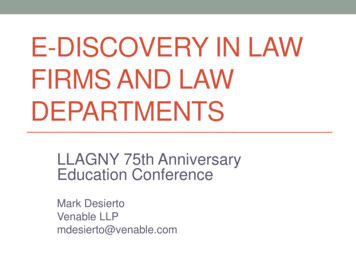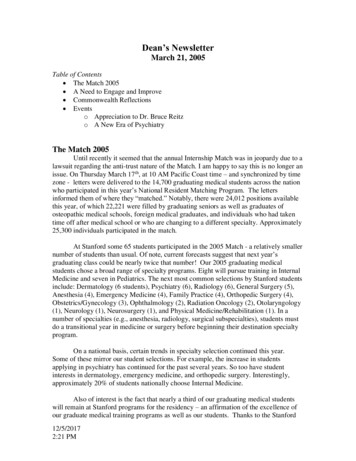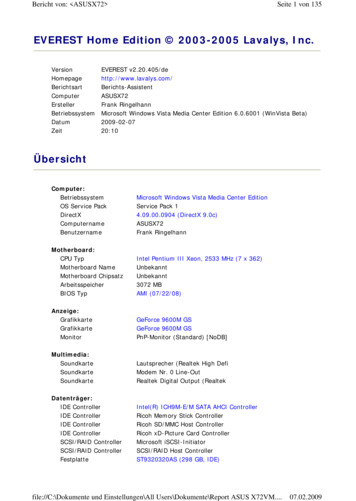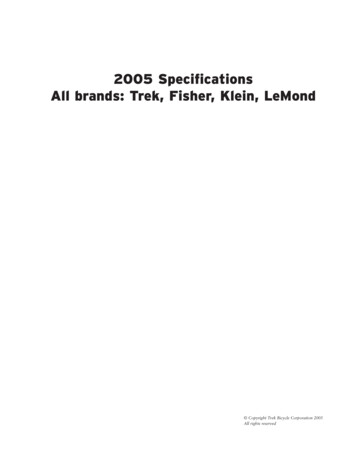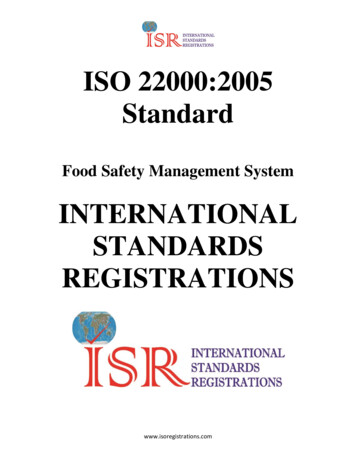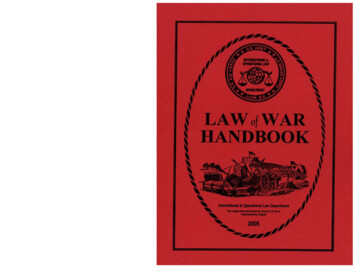
Transcription
LAW OF WAR HANDBOOK(2005)MAJ Keith E. PulsEditor'Contributing AuthorsMaj Derek Grimes, USAFLt Col Thomas Hamilton, USMCMAJ Eric JensenLCDR William O'Brien, USNMAJ Keith PulsNIAJ Randolph SwansigerLTC Daria WollschlaegerAll of the faculty who have served before usand contributed to the literature in the field of operational law.Technical SupportCDR Brian J. Bill, USNMs. Janice D. Prince, SecretaryJA 423International and Operational Law DepartmentThe Judge Advocate General's Legal Center and SchoolCharlottesville, Virginia 22903
PREFACEThe Law of War Handbook should be a start point for Judge Advocates looking for information onthe Law of War. It is the second volume of a three volume set and is to be used in conjunction withthe Operational Law Handbook (JA422) and the Documentary Supplement (JA424). TheOperational Law Handbook covers the myriad of non-Law of War issues a deployed Judge Advocatemay face and the Documentary Supplement reproduces many of the primary source documentsreferred to in either of the other two volumes. The Law of War Handbook is not a substitute forofficial references. Like operational law itself, the Handbook is a focused collection of diverse legaland practical information. The handbook is not intended to provide "the school solution" to aparticular problem, but to help Judge Advocates recognize, analyze, and resolve the problems theywill encounter when dealing with the Law of War.The Handbook was designed and written for the Judge Advocates practicing the Law of War. Thisbody of law is known by several names including the Law of War, the Law of Armed Conflict andInternational Humanitarian Law. While these terms may largely be used interchangeably, forhistorical and contextual reasons, the Law of War will be used in this publication. Unless otherwisestated, masculine pronouns apply to both men and women.The proponent for this publication is the International and Operational Law Department, The JudgeAdvocate General's Legal Center and School (TJAGLCS). Send comments, suggestions, and workproduct from the field to TJAGLCS, International and Operational Law Department, Attention: MAJKeith Puls, 600 Massie Road, Charlottesville, Virginia 22903-1781. To gain more detailedinformation or to discuss an issue with the author of a particular chapter or appendix call MAJ Puls atDSN 521-33 10; Commercial (434) 971-33 10; or email keith.puls@hqda.army.mil.The 2004 Law of War Handbook is on the Internet at www.jagcnet.army.mil. After accessing thissite, Enter JAGCNet, then go to the International and Operational Law sub-directory. The 2004edition is also linked to the CLAMO General database under the keyword Law of War Handbook 2004 edition. The digital copies are particularly valuable research tools because they contain manyhypertext links to the various treaties, statutes, DoD Directives/Instructions/Manuals,CJCSInstructions, Joint Publications, Army Regulations, and Field Manuals that are referenced in the text.If you find a blue link, click on it and Lotus Notes will retrieve the cited document from the Internetfor you. The hypertext linking is an ongoing project and will only get better with time. A word ofcaution: some Internet links require that your computer contain Adobe Acrobat software.To order copies of the 2004 Law of War Handbook, please call CLAMO at (434) 971 3339 or emailCLAMO@hqda.army.mil.
TABLE OF CONTENTSHistory of the Law of War .Chapter 1Framework of the Law of War .Chapter 2Legal Basis for the Use of Force . Chapter 3Geneva Convention I (Wounded and Sick in the Field) . Chapter 4Geneva Convention 111(Prisoners of War) . Chapter 5Geneva Convention N (Civilians) .Chapter 6Means and Methods of Warfare . Chapter 7War Crimes and Command Responsibility .Chapter 8Applying the Law of War in Operations Other Than War .Chapter 9Human Rights .Chapter 10
EXPANDED TABLE OF CONTENTSHistory of the Law of War .1Framework of the Law of War .19Legal Basis for the Use of Force . 35Geneva Convention I: Wounded and Sick in the Field .51Geneva Convention 111: Prisoners of War . 75Appendix A . CENTCOM Reg 27-13 (Determination of EPW Status) . 116Geneva Convention IV:Protection of Civilians in Armed Conflict . 137Means and Methods of Warfare .163199War Crimes and Command Responsibility .Appendix A . US Position regarding ICC . 228Appendix B. Milosevic Indictment Excerpt. 234The Law of War and Military Operations Other Than War . 241Appendix A . CPL and Civilian Detainment . 262Appendix B. CPL and the Treatment of Property . 268Appendix C. CPL and Displaced Persons . 271281Human Rights .Appendix A . Universal Declaration of Human Rights . 291
HISTORY OF THE LAW OF WARREFERENCESDept. of Army, Pamphlet 27-1, Treaties Governing Land Warfare (7 December 1956) [hereinafter DAPAM 27-11 (reprinted in Documentary Supplement).Dept. of Army, Pamphlet 27-1-1, Protocols To The Geneva Conventions of 12 August 1949 (1September 1979). [hereinafter DA PAM 27-1-11 (reprinted in Documentary Supplement).Dept. of Army, Pamphlet 27-161-2, Intemational Law, Vol. I1 (23 October 1962). [hereinafter DAPAM 27-16 1-21 (no longer in print).Intemational Committee of the Red Cross, Commentary on the Geneva Convention (1) for theAmelioration of the Condition of the Wounded and Sick in Armed Forces in the Field (Jean S.Pictet ed., 1952) [hereinafter Pictet]Leon Fnedman, The Law of War--A Documentary History--Vol. I (1972).Lothar Kotzsch, The Concept of War In Contemporary History and Intemational Law (1956).Julius Stone, Legal Controls of International Conflict (1954).John N. Moore, National Security Law (1990).L. Oppenheim, Intemational Law Vol. I1 Disputes, War and Neutrality (7Ihed. 1952).10. Gerhard von Glahn, Law Among Nations (1992).11. Michael Walzer, Just and Unjust Wars (1977).12. Percy Bordwell, The Law of War Between Belligerents: A History and Commentary (1908).13. Chris Jochnick and Roger Normand, The Legitimization of Violence: A Critical History of theLaws of War, 35 HARV.INT'L.L. J. 49 (Winter, 1994).14. Eric S. Kra issand Mike 0. Lacey, Utilitarian vs. Humanitarian: The Battle Over the Law ofWar, PARAMETERS,Summer 2002.15. Scott Morris, The Laws of War: Rules for Warriors by Warriors, ARMYLAWYER,Dec. 1997.16. Gregory P. Noone, The History and Evolution of the Law of War Prior to World War II,47NAVALL. REV. 176 (2000).I.INTRODUCTION.A. OBJECTIVES:1. Identify common historical themes that continue to support the validity oflaws regulating warfare.2. Identify the two "prongs" of legal regulation of warfare.3. Trace the historical "cause and effect" evolution of laws related to theconduct of war.
4. Begin to analyze the legitimacy of injecting law into warfare.B. The "law of war" is the "customary and treaty law applicable to the conduct ofwarfare on land and to relationships between belligerents and neutral states."(FM 27-10, para. 1). It "requires that belligerents refrain from employing anykind or degree of violence which is not actually necessary for military purposesand that they conduct hostilities with regard for the principles of humanity andchivalry." FM 27-10, para. 3. It is also referred to as the Law of ArmedConflict or Humanitarian Law, though some object to the latter reference as it issometimes used to broaden the traditional content of the law of war.C. As illustrated by the diagram on page 3, the law of war is a part of the broaderbody of law known as public international law. International law is defined as"rules and principles of general application dealing with the conduct of statesand of international organizations and with their relations inter se, as well assome of their relations with persons, natural or juridical." (Restatement of theLaw, Third, Foreign Relations Law of the United States, 101.) Publicinternational law is that portion of international law that deals mainly withintergovernmental relations.D. The law of war has evolved to its present content over millennia based on theactions and beliefs of nations. It is deeply rooted in history and anunderstanding of this history is necessary to understand current law of warprinciples.
I International LawPrivate Law commercial lawPublic Law intergovernmentalLaw of ArmedConflictConflictManagement(Jus ad Bellum)kU.N. CharteRules ofHostilities(Jus in Bello)Hague Conventions(means & r IHistory of LOW
E. WHAT IS WAR? "It is possible to argue almost endlessly about the legaldefinition of "war." (Pictet, p. 32).1. International Legal Definition: The Four Elements Test.a. A contention;b. Between at least two nation states;c. Wherein armed force is employed;d. With an intent to overwhelm.2. War versus Armed Conflict. Historically, only conflict meeting the fourelements test for "war" triggered law of war application. Accordingly, somenations asserted the law of war was not triggered by all instances of armedconflict. As a result, the applicability of the law of war depended upon thesubjective national classification of a conflict.a. Post WW I1 response. Recognition of a state of war is no longer requiredto trigger the law of war. Instead, the law of war is applicable to anyinternational armed conflict:(1)"Any difference arising between two States and leading to theintervention of armed forces is an armed conflict . . . [i]t makes nodifference how long the conflict lasts, or how much slaughter takesplace." (Pictet, p. 32).11.THE UNIFYING THEMES OF THE LAW OF WAR.A. Law exists to either (1) prevent conduct or, (2) control conduct. Thesecharacteristics permeate the law of war, as exemplified by the two prongs. Jusad Bellum serves to prevent conduct, while Jus in Be110 serves to regulate orcontrol conduct.1. Validity. Although critics of regulating warfare cite historic examples ofviolations of evolving laws of war, history provides the greatest evidence ofthe validity of this body of law.a. History shows that in the vast majority of instances the law of war works.Despite the fact that the rules are often violated or ignored, it is clear thatmankind is better off with them than without them.
b. History demonstrates that mankind has always sought to limit the affect ofconflict on the combatants and has come to regard war not as a state ofanarchy justifying infliction of unlimited suffering, but as an unfortunatereality which must be governed by some rule of law.(1)This point is exemplified by Article 22 of the Hague Convention: "theright of belligerents to adopt means of injuring the enemy is notunlimited, and this rule does not lose its binding force in a case ofnecessity."(2)That regulating the conduct of warfare is ironically essential to thepreservation of a civilized world was exemplified by GeneralMacArthur, when in confirming the death sentence for JapaneseGeneral Yamashita, he wrote: "The soldier, be he friend or foe, ischarged with the protection of the weak and unarmed. It is the veryessence and reason of his being. When he violates this sacred b s t , henot only profanes his entire cult but threatens the fabric of internationalsociety."B. The trend toward regulation grew over time in scope and recognition. Whenconsidering whether these rules have validity, the student and the teacher ('judgeadvocates teaching soldiers) must consider the objectives of the law of War.1. The purpose of the law of war is to (1) integrate humanity into war and (2)serve as a tactical combat multiplier.2. The validity of the law of war is best explained in terms of both objectives.For instance, many site the German massacre at Malmedy as providingAmerican forces with the inspiration to break the German advance duringWorld War 11's Battle of the Bulge. Accordingly, observance of the law ofwar denies the enemy a rallying cry against difficult odds.111. JUS AD BELLUM AND JUS IN BELL0A. The law of armed conflict is generally divided into two major categories, Jus adBellum and Jus in Bello.B. Jus ad Bellum is the law dealing with conflict management, of the lawsregarding how states initiate armed conflict; under what circumstances was theuse of military power legally and morally justified.
C . Jus in Bello is the law governing the actions of states once conflict has started;what legal and moral restraints apply to the conduct of waging war.D. Both categories of the law of armed conflict have developed over time, drawingmost of their guiding principles from history.E. The concepts of Jus ad Bellurn and Jus in Bello developed both unevenly andconcurrently. For example, during the majority of the Jus ad Bellum period,most societies only dealt with rules concerning the legitimacy of using force.Once the conditions were present that justified war, there were often no limits onthe methods used to wage war. At a certain point both theories began to evolvetogether.IV. ORIGINS OF' JUS AD BELLUMA. Jus ad Bellum: Legtimate War. Law became an early player in the historicaldevelopment of warfare. The earliest references to rules regarding war referredto the conditions that justified resort to war legally and morally.1. Greeks: began concept of Jus ad Bellurn, wherein a city state was justified inresorting to the use of force if a number of conditions existed (if theconditions existed the conflict was blessed by the gods and was just). In theabsence of these conditions armed conflict was forbidden.2. Romans: formalized laws and procedures that made the use of force an act oflast resort. Rome dispatched envoys to the nations against whom they hadgrievances, and attempted to resolve differences diplomatically. TheRomans also are credited with developing the requirement for declaring war.Cicero wrote that war must be declared to be just.3. The ancient Egyptians and Sumerians (2nd millennium B.C.) generated rulesdefining the circumstances under which war might be initiated.4. The ancient Hittites required a formal exchange of letters and demandsbefore initiating war. In addition, no war could begin during planting season.5. Deuteronomy 20. "Before attacking an enemy city make an offer of peace."
V.THE HISTORICAL PERIODS.A. THE JUST WAR PERIOD.,1. This period ranged from 335 B.C. to about 1800 A.D. The primary tenant ofthe period was determination of a "just cause" as a condition precedent to theuse of military force.2. Just Conduct Valued Over Regulation of Conduct. The law during thisperiod focused upon the first prong of the law of war (Jza ad Bellum). If thereason for the use of force was considered to be just, whether the war wasprosecuted fairly and with humanity was not a significant issue.3. Earlv Beginnings: Just War Closelv Connected to Self-Defense.a. Aristotle (335 B.C.) wrote that war should only be employed to (1)prevent men becoming enslaved, (2) to establish leadership which is in theinterests of the led, (3) or to enable men to become masters of men whonaturally deserved to be enslaved.b. Cicero refined Aristotle's model by stating that "the only excuse for goingto war is that we may live in peace unharmed."4. The Era of Christian Influence: Divine Justification.a. Early church leaders forbade Christians from employing force even inself-defense. This position became less and less tenable with theexpansion of the Christian world.b. Church scholars later reconciled the dictates of Christianity with the needto defend individuals and the state by adopting a Jus ad Bellum positionunder which recourse to war was just in certain circumstances (6thcentury A.D.).5. Middle Ages. Saint Thomas Aquinas (12th century A.D.) (within his SummaTheologica) refined this "just war" theory when he established the threeconditions under which a just war could be initiated:a. with the authority of the sovereign;b. with a just cause (to avenge a wrong or fight in self-defense); and
c. so long as the fray is entered into with pure intentions (for theadvancement of good over evil). The key element of such an intentionwas to achieve peace. This was the requisite "pure motive."6. Juristic Model. Saint Thomas Aquinas' work signaled a transition of the JustWar doctrine from a concept designed to explain why Chnstians could beararms (apologetic) towards the beginning of a juristic model.a. The concept of "just war" was initially enunciated to solve the moraldilemma posed by the adversity between the Gospel and the reality ofwar. With the increase in the number of Christian nation-states, thisconcept fostered an increasing concern with regulating war for morepractical reasons.b. The concept of just war was being passed from the hands of thetheologians to the lawyers. Several great European jurists emerged todocument customary laws related to warfare. Hugo Grotius (15 83-1645)produced the most systematic and comprehensive work, On the Law ofWar and Peace. His work is regarded as the starting point for thedevelopment of the modem law of war.c. While many of the principles enunciated in this work were consistent withchurch doctrine, Grotius boldly asserted a non-religious basis for this law.According to Grotius, the law of war was not based on divine law, but onrecognition of the true natural state of relations among nations. Thus, thelaw of war was based on natural, and not divine law.7. The End of the Just War Period. By the time the next period emerged, theJust War Doctrine had generated a widely recognized set of principles thatrepresented the early customary law of war. The most fundamental of theseprinciples are:a. A decision to wage war can be reached only by legitimate authority (thosewho rule, e.g. the sovereign).b. A decision to resort to war must be based upon a need to right an actualwrong, in self-defense, or to recover wrongfully seized property.c. The intention must be the advancement of good or the avoidance of evild. In war, other than in self-defense, there must be a reasonable prospect ofvictory.8C ' i l ( l / ? l 1 l-Jt iotj L J " /U l i '
e. Every effort must be made to resolve differences by peaceful means,before resorting to force.f. The innocent shall be immune from attack.g. The amount of force used shall not be disproportionate to the legitimateobjective.B. THE WAR AS FACT PERIOD (1 800-1918).1. Generally. This period saw the rise of the nation state as the principleelement used in foreign relations. These nation states transformed war froma tool to achieve justice to something that was a legitimate tool to use inpursuing national policy objectives.a. Just War Notion Pushed Aside. Natural or moral law principles replacedby positivism that reflected the rights and privileges of the modem nationstate. Law is based not on some philosophical speculation, but on rulesemerging from the practice of states and international conventions.b. Basic Tenets: Since each state is sovereign, and therefore entitled to wagewar, there is no international legal mandate, based on morality or nature,to regulate resort to war (realpolitik replaces justice as reason to go towar). War is (based upon whatever reason) a legal and recognized rightof statehood. In short, if use of military force would help a nation stateachieve its policy objectives, then force may be used.c. Clausewitz. This period was dominated by the realpolitik of Clausewitz.He characterized war as a continuation of a national policy that is directedat some desired end. Thus, a state steps from diplomacy to war, notalways based upon a need to correct an injustice, but as a logical andrequired progression to achieve some policy end.d. Things to Come. The War as Fact Period appeared as n dark ern for therule of law. Yet, a number of significant developments signaled thebeginning of the next period.2. Established the Foundation for upcoming "Treaty Period." Based on the"positivist" view, the best way to reduce the uncertainty attendant withconflict was to codify rules regulating this area.a. Intellectual focus began shft toward minimizing resort to war and/ormitigating the consequences of war.
b. EXAiMPLE: National leaders began to join the academics in the push tocontrol the impact of war (Czar Nicholas and Theodore Roosevelt pushedfor the two Hague Conferences that produced the Hague Conventions andRegulations).C. JUS CONTRA BELLUM PERIOD.1. Generally. World War I represented a significant challenge to the validity ofthe "war as fact" theory.a. In spite of the moral outrage directed towards the aggressors of that war,legal scholars unanimously rejected any assertion that initiation of the warconstituted a breach of international law.b. World leaders struggled to give meaning to a war of unprecedentedcarnage and destruction. The "war to end all wars" sentiment manifesteditself in a shift in intellectual direction leading to the conclusion thataggressive use of force must be outlawed.2 . JLLSad Bellz mChanges Shape. Immediately before this period began, theHague Conferences (1899- 1907) produced the Hague Conventions, whichrepresented the last multilateral law that recognized war as a legitimatedevice of national policy. While Hague law concentrates on war avoidanceand limitation of suffering during war, this period saw a shift toward anabsolute renunciation of aggressive war.a. League of Nations. First time in history that nations agreed upon anobligation under the law not to resort to war to resolve disputes or tosecure national policy goals (Preamble). The League was set up as acomponent to the Treaty of Versailles, largely because President Wilsonfelt that the procedural mechanisms put in place by the Covenant of theLeague of Nations would force delay upon nations bent on war. Duringthese periods of delay peaceful means of conflict management could bebrought to bear.b. Eighth Assembly of League of Nations: banned aggressive war(questionable legal effect of resolution). However, the League did notattempt to enforce this duty (except as to Japan's invasion of Manchuria in1931).
c. Kellogg-Briand Pact (1928). Officially referred to as the Treaty for theRenunciation of War, it banned aggressive war. This is the point in timegenerally thought of as the "quantum leap." For the first time, aggressivewar is clearly and categorically banned. In contradistinction from the postWW I period, this treaty established an international legal basis for thepost WW I1 prosecution of those responsible for waging aggressive war.d. Current Status of Pact. This treaty remains in force today. Virtually allcommentators agree that the provisions of the treaty banning aggressivewar have ripened into customary international law.3. Use of force in self-defense remained unregulated. No law has everpurported to deny a sovereign the right to defend itself. Some commentatorsstated that the use of force in the defense is not war. Thus, war has beenbanned altogether.D. POST WORLD WAR I1 PERIOD.1. Generally. The Procedural requirements of the Hague Conventions did notprevent World War I; just as the procedural requirements of the League ofNations and the Kellogg-Briand Pact did not prevent World War 11. Worldpowers recognized the need for a world body with greater power to preventwar, and international law that provided more specific protections for thevictims of war.2. Post-WWII War Crimes Trials (Nuremberg, Tokyo, and Manila Tribunals).The trials of those who violated international law during World War I1demonstrated that another quantum leap had occurred since World War I.a. Reinforced tenants of Jzis ad Bellurn and Jus in BeZlo, and ushered in theera of "universality," establishing the principle that all nations are boundby the law of war based on the theory that law of war conventions largelyreflect customary international law.b. World focused on ex post facto problem during prosecution of warcrimes. The universal nature of law of war prohibitions, and therecognition that they were at the core of international legal values Guscogens), resulted in the legitimate application of those laws to those triedfor violations.E. The United Nations Charter. Continues shift to outright ban on war. Extendedban to not only war, but through Article 2(4), also "the threat or use of force."
1. Early Charter Period. Immediately after the negotiation of the Charter in1945, many nations and commentators assumed that the absolute language inthe Charter's provisions permitted the use of force only if a nation hadalready suffered an armed attack.2. Contemporary Period. Most nations now agree that a nation's ability todefend itself is much more expansive than the provisions of the Charter seemto permit based upon a literal reading. This view is based on the conclusionthat the inherent right of self-defense under customary international law wassupplemented, and not displaced by the Charter. This remains acontroversial issue.F. Jus ad Bellum continues to evolve. Current doctrines such as anticipatory selfdefense and preemption are adapted to meet today's circumstances.VI. ORIGINS OF JUS IN BELL0A. Jus in Bello: Regulation of Conduct During War. The second body of law thatbegan to develop dealt with rules that control conduct during the prosecution ofa war to ensure that it is legal and moral.1. Ancient China (4th century B.C.). Sun Tzu's The Art of War set out anumber of rules that controlled what soldiers were permitted to do duringwar:a. captives must be treated well and cared for; andb. natives within captured cities must be spared and women and childrenrespected.2. Ancient India (4th century B.C.). The Hindu civilization produced a body ofmles codified in the Book of Manu that regulated in great detail land warfare.3. Ancient Babylon (7th century B.C.). The ancient Babylonians treated bothcaptured soldiers and civilians with respect in accordance with wellestablished rules.B. Jus in Bello received little attention until late in the Just War period. This led tothe emergence of a Chivalric Code. The chivalric rules of fair play and goodtreatment only applied if the cause of war was "just" from the beginning.12C hcrptet 1: [ / / o i ( I/ I-;,Ii
1. Victors were entitled to spoils of war, only if war was just.2. Forces prosecuting an unjust war were not entitled to demand Jus in Belloduring the course of the conflict.3. Red Banner of Total War. Signaled a party's intent to wage absolute war(Joan of Arc announced to British "no quarter will be given").C. During the War as Fact period, the focus began to change from Jus ad Bellurn toJus in Bello also. With war a recognized and legal reality in the relationsbetween nations, the focus on mitigating the impact of war emerged.1. A Memory of Solferino (Henry Dunant's graphic depiction of the bloodiestbattles of Franco-Prussian War). His work served as the impetus for thecreation of the International Committee of the Red Cross and the negotiationof the First Geneva Convention in 1864.2. Francis Lieber. Instructions To Armies in the Field (1863). First modemrestatement of the law of war issued in the form of General Order 100 to theUnion Army during the American Civil War.3. International Revulsion of General Sherman's "War is Hell" Total War.Sherman was very concerned with the morality of war. His observation thatwar is hell demonstrates the emergence and reintroduction of morality.However, as his March to the Sea demonstrated, Sherman only thought theright to resort to war should be regulated. Once war had begun, he felt it hadno natural or legal limits. In other words he only recognized the first prong(Jus ad Bellum) of the law of war.4. At the end of this period, the major nations held the Hague Conferences(1899-1907) that produced the Hague Conventions. While some Hague lawfocuses on war avoidance, the majority of the law dealt with limitation ofsuffering during war.D. Geneva Conventions (1949).1. Generally.a. "War" v. "Armed Conflict." Article 2 common to all four GenevaConventions ended this debate. Article 2 asserts that the law of warapplies in any instance of international armed conflict.b. Four Conventions. A comprehensive effort to protect the victims of war.
c. Birth of the Civilian's Conventio
The Law of War Handbook should be a start point for Judge Advocates looking for information on the Law of War. It is the second volume of a three volume set and is to be used in conjunction with the Operational Law Han

